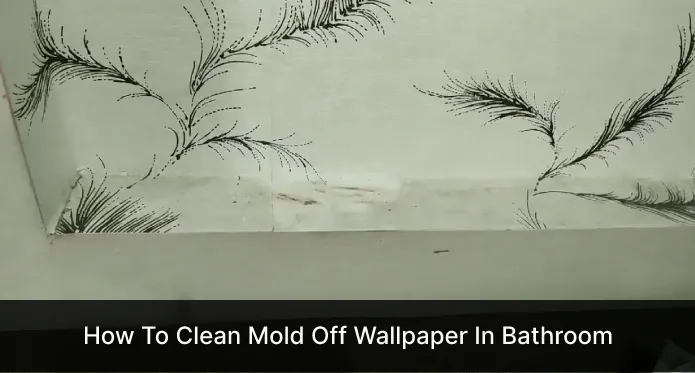Last Updated on September 6, 2023
If you’ve noticed mold growing on your bathroom wallpaper, you know it can be a considerable nuisance. Not only is it unsightly, but it can also cause unpleasant odors and affect your health. Fortunately, there are steps you can take to effectively clean mold off your wallpaper and make sure it doesn’t grow back.
The key is to identify the mold type, remove the moisture source, wear protective gear, clean the mold, dry the area thoroughly and inspect for mold growth below the wallpaper.
We’ll discuss the steps to take to clean mold off wallpaper in the bathroom, from identifying the type of mold to checking for growth behind the wallpaper. Following these instructions and taking proper precautions can eliminate mold growth in your bathroom and keep your home safe and healthy.
How To Clean Mold Off Wallpaper In Bathroom: DIY Steps

Step 1: Identify the Type of Mold
The first step in cleaning bathroom wallpaper of mold is to identify the type of mold. It is important to correctly identify the type of mold, as this will determine the best course of action for remediation.
If you would like an accurate assessment, you should contact a mold remediation service. This can help prevent any unnecessary damage or health risks due to improper removal methods.

Step 2: Remove the Source of Moisture
The next step is to remove the source of moisture that caused the growth of the mold in the first place. This may involve repairing plumbing and other water systems, such as replacing leaky faucets or repairing expired caulking around tubs and showers.
Additionally, you should ensure proper ventilation throughout your bathroom by running fans or opening windows when possible. This will help keep air circulating and reduce any excess humidity levels that could promote further mold growth.
Step 3: Wear Protective Gear
Before beginning any remediation process, it is essential to take safety precautions by wearing protective gear, such as gloves and a mask designed specifically for mold removal.
Doing so can help prevent inhaling airborne spores or coming into direct contact with potentially hazardous materials during cleanup.
Step 4: Clean The Mold
Once you have identified the type of mold and removed its source of moisture, you can begin cleaning it off from your wallpaper using non-toxic household cleaners like vinegar and baking soda mixed in equal parts.
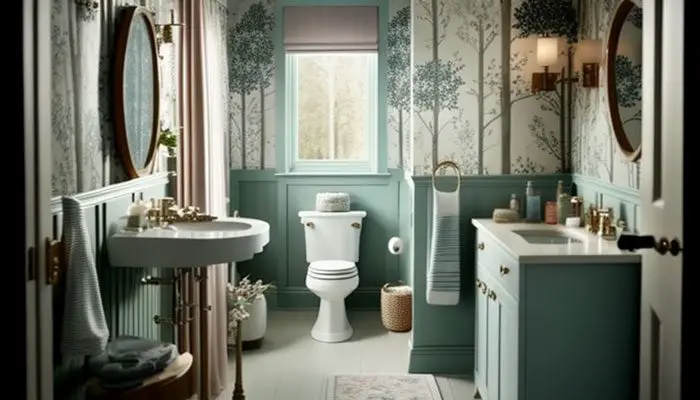
Ensure that you scrub well with a brush or sponge until all traces of mold are gone from your walls before rinsing with warm water. Take care not to spread any further contamination during this process by using clean supplies each time you move onto a new surface area for scrubbing.
Step 5: Dry The Area Thoroughly
After cleaning off your walls and removing any excess moisture, dry out the area thoroughly with a towel or rag, so no remaining spores can settle back onto your walls before they have had a chance to be washed away thoroughly.
Check for moisture in difficult-to-access places, such as wall cracks or under baseboards near flooring edges. Dampness could be caused by hidden issues like leaking pipes and fixtures that might not become apparent until serious damage occurs if left unchecked over time.
Utilizing a dehumidifier or fan can help ensure your bathroom stays dry and safe from costly water seepage down the line.
Step 6: Check For Mold Growth Behind the Wallpaper
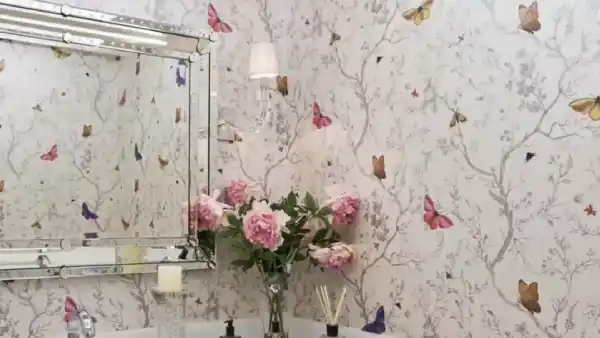
Finally, check behind your wallpaper for any remaining spots where residual moisture could be present that might still allow for potential future outbreaks even after the initial clean-up has been completed successfully.
This can happen if the wallpaper has been applied directly onto walls without proper sealing beforehand. If found necessary, replace all affected sections immediately following the same procedures outlined above once again.
Be sure to take extra care to maintain existing wallpaper during the process, further exacerbating the problem instead of improving upon it. Despite best intentions otherwise, at the outset was meant to be initially accomplished.
Negative Consequences of Mold Growth On Bathroom Wallpapers
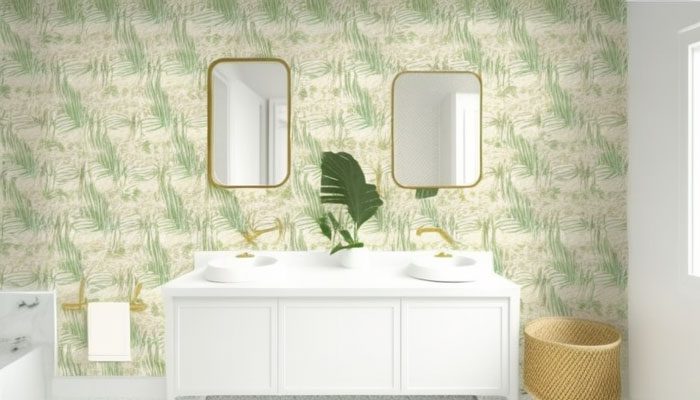
01. Health Risks
Mold growing on wallpapers in the bathroom can be a major source of health risks. It is particularly dangerous for people with underlying respiratory conditions or weakened immune systems, as it can cause adverse reactions such as breathing difficulty, coughing, sneezing, and asthma attacks.
Furthermore, mold spores can be inhaled and absorbed through the skin, leading to infections and other problems. In extreme cases, exposure to toxic mold has been linked to more serious medical issues such as cancer, neurological disorders, and even death if left untreated.
02. Property Damage
In addition to health risks, mold growth on wallpapers in a bathroom can lead to property damage. This includes discoloration of walls and objects within the vicinity caused by excessive moisture released from the spores of the mold.
If left unchecked for too long, it can spread beyond its original area and cause further damage to surrounding surfaces like floors and ceilings.
Depending on the type of wallpaper used and how deep into it the mold has gone, removing it may require replacing large sections of wallpaper or even an entire wall’s worth of material.
03. Musty or Damp Smell

Another consequence of mold growing on bathroom wallpapers is an unpleasant musty, or damp smell.
Unlike other molds found indoors, which tend to emit a milder odor, bathroom molds produce a much stronger scent due to their close proximity to higher humidity levels generated by regular bathing activities.
The smell can quickly spread throughout the house if not contained early enough. It can also make sleeping in that particular room difficult due to its strong presence at night when many people are trying to rest.
04. Cost of Removing and Repairing Mold Damage
Cleaning up extensively damaged wallpaper from a severe case of mold growth can become quite costly, depending on how long it was left before the removal was started.
Professionals might need to be called to determine what needs to be replaced versus what can be salvaged for cleaning purposes or covered up with new wallpaper materials.
There could also be additional costs associated with repairing any structural damage done by water seeping through where the mold had taken hold for too long.
This could include rotting wood frames around windows or doors nearby and possible electrical wiring complications if left unchecked longer than necessary.
05. Allergic Reactions
People who have allergies often experience worse symptoms when exposed to environmental molds, like those found in bathrooms during high humidity periods after taking showers or baths.
Additionally, they may develop additional allergies which did not exist before prolonged contact with these same molds over time. Those affected may find themselves experiencing symptoms such as sneezing fits accompanied by more persistent coughing spells.
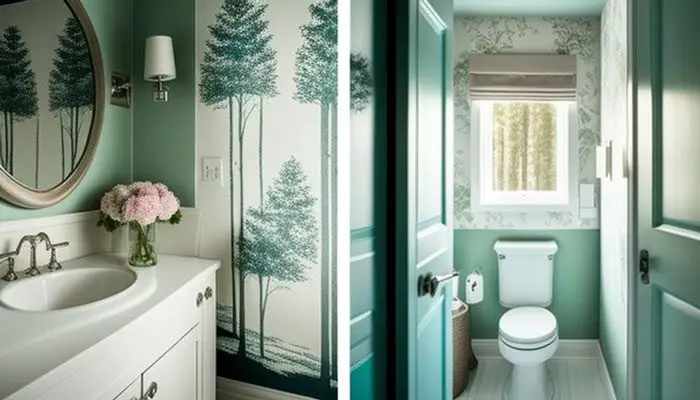
They may also experience clogged noses and headaches during days when humidity levels are higher than normal in their homes due to these molds being present in their environment without proper containment measures being taken against them right away when first noticed indoors.
06. Reduction in Property Value
Lastly, having spent money on remedying extensive damages caused by mold growth on bathroom wallpapers will ultimately reduce your property’s value since prospective buyers would expect some form of compensation for having dealt with such issues once you list your home for sale down the line.
Selling a home can be costly if proper preventive maintenance isn’t taken. Paying for excessive repairs due to neglect may lead one down an expensive and ultimately pointless path, costing the homeowner in more ways than expected.
Why Does Mold Grow On Bathroom Wallpapers?
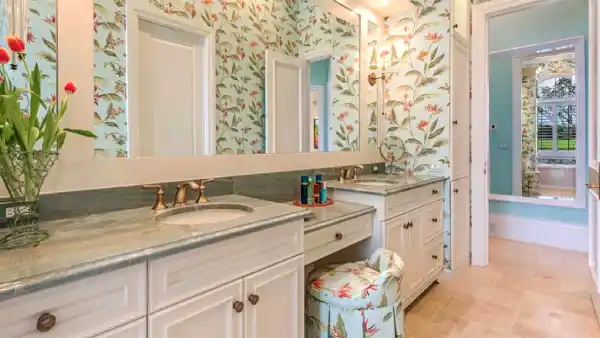
Mold growth on bathroom walls is often linked to moisture, organic material, poor ventilation, lack of light, dirt, and leaks.
01. Moisture
Mold loves moisture and needs it to grow. Bathrooms are usually damp places both due to their constant use, as well as their exposure to high humidity levels.
This means that the walls and wallpaper will be regularly exposed to water, creating a conducive environment for mold growth.
Moisture also provides the perfect conditions for organic material, such as dust and dirt particles, to settle on the wallpaper and provide nutrition for bacteria and fungi, which can develop into mold.
02. Organic material
Organic material is essential for mold growth because it provides nutrients for them to survive and thrive. Common sources of organic materials used in wallpaper production include wood pulp, cotton rag, and natural fibers like hemp and flax.
These materials are often rich in carbohydrates, proteins, and other compounds that act as food sources for molds. As they break down these substances, they release toxins into the air that can cause health issues.
03. Poor ventilation
Poor ventilation is one of the leading causes of mold formation on bathroom wallpapers. When there is inadequate air circulation in a bathroom, moisture becomes trapped and can cause condensation on surfaces such as wallpaper.
This condensation, when combined with warm temperatures, creates the ideal environment for mold spores to thrive. Poor ventilation also allows airborne contaminants to settle onto the wallpaper, which can serve as food sources for mold.
A lack of airflow will often result in a poor dispersal of indoor pollutants from cleaning products, which may further contribute to harmful indoor air quality levels and promote fungal growth.
04. Lack of light
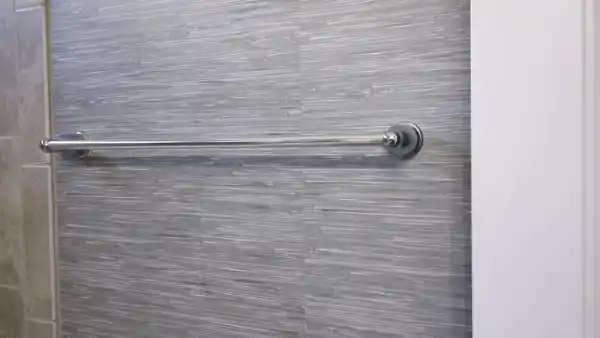
Mold growth on bathroom wallpapers can also be caused by a lack of light in the room. Bathrooms are typically designed with little or no natural light, so artificial lighting is used instead.
This lighting emits less ultraviolet radiation than natural sunlight, making it difficult for mold microspores to die naturally. As a result, they continue to spread and cause staining and discoloration on wallpaper over time.
Additionally, the lack of light makes it difficult to spot the presence of mold until it has spread significantly across the walls or ceiling areas. Bathrooms must be well-lit, naturally or artificially, to prevent fungal growths on surfaces like wallpaper.
05. Dirty
Dirty bathrooms are also often more prone to mold problems due to accumulated dirt and grime acting as food sources for the growing molds.
Keeping the bathroom clean is essential for controlling mold growth, as dirty surfaces provide fertile grounds for molds to thrive upon.
Regular cleaning using appropriate cleaners helps remove dirt particles that may act as food sources for the molds while also preventing accumulations of dust which could act similarly by providing sustenance for growing molds.
06. Leaks
Leaky pipes and leaking fixtures can be one of the primary sources of dampness in bathrooms which leads to mold growth.
When water leaks onto wallpaper, it gives mold spores a chance to germinate and provides them with the moisture they need to multiply.
Leaking plumbing and fixtures should be repaired or replaced as soon as possible to avoid long-term damage to wallpaper and other materials due to mold growth.
What are the Health Risks of Mold Exposure in the Bathroom?
Mold exposure in the bathroom can have various health risks. Exposure to mold can cause irritation of the eyes, skin, and breathing passages. It may cause coughing, wheezing, and other respiratory problems.
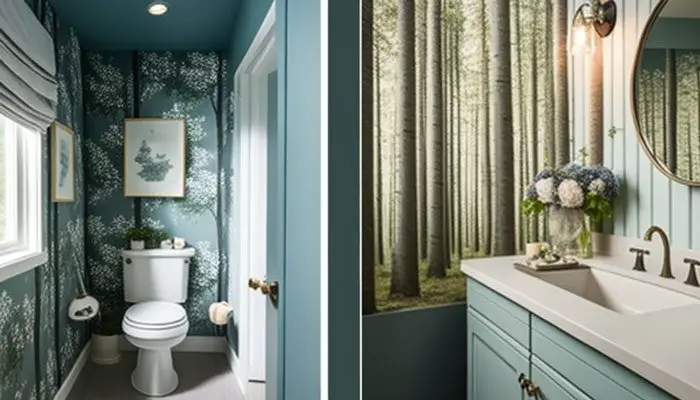
People with allergies or asthma may be more sensitive to mold. Long-term exposures may lead to more serious health conditions such as fever, shortness of breath, chest pain, and sinus infections.
For individuals with weakened immune systems or those with chronic lung illnesses, mold exposure can cause serious illness or death.
Is It Safe to Use Bleach to Kill Mold in the Bathroom?

Bleach can kill mold in the bathroom, but caution should be taken when handling bleach due to its strong chemical properties. Wear protective clothing when working with bleach, such as gloves and safety goggles. Working with bleach can irritate your skin and damage your eyes if not handled properly.
Use bleach only on non-porous surfaces such as tiles and glass surfaces. Bleach could seep into porous materials like wood and drywall, causing further contamination of your home environment.
Here is how to properly use bleach to kill mold on bathroom surfaces.
- Mix a solution of equal parts water and bleach (1 cup of each) in a spray bottle,
- Then spray onto areas affected by mold growth and let sit for 10 minutes before scraping away the dead spores using a scrub brush.
- Once all visible signs of mold are gone, wipe the area with clean water before drying thoroughly.
Mold-Free Bathroom Walls: Guide to Safe and Easy Cleaning
Cleaning mold off wallpaper in your bathroom doesn’t have to be a daunting task. With careful preparation, homeowners can easily accomplish this task independently. Knowledge of the types of mold present and following each step safely and thoroughly is important.
From removing excess moisture sources to wearing protective gear while cleaning, these measures will ensure that no further damage occurs during the process.
We hope that the information in this article has been helpful in providing you with information about how to clean mold-off wallpaper in the bathroom successfully.
It also helps you so that your walls remain healthy and that your walls remain beautiful in the future.

